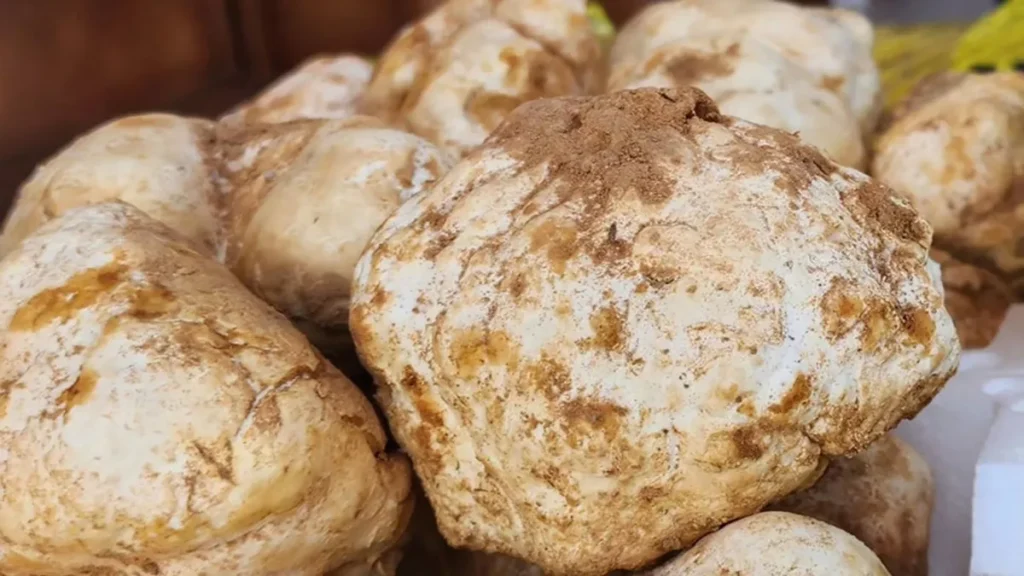Desert truffles, known locally as “terfez” in North Africa and as “faqaa” or “kama” in the Gulf Cooperation Council (GCC) region, are a culinary and cultural treasure. These rare fungi thrive in arid landscapes, such as Algeria’s Sahara Desert, and have been harvested for centuries for their delicate flavour, nutritional benefits, and economic value. For distributors and gourmet markets, sourcing these gems is not just a business—it’s an art form steeped in tradition, sustainability, and cultural heritage.
What Are Desert Truffles?
Desert truffles are a unique variety of fungi that grow symbiotically with certain desert plants, such as the Helianthemum(rockrose). Unlike European black or white truffles, desert truffles are less intense in flavour but highly prized for their subtle, nutty taste and versatility in both traditional and gourmet dishes.
The primary varieties of desert truffles found in Algeria and North Africa include:
- Tirmania nivea: Light in colour with a delicate, mild flavour, ideal for soups and stews.
- Terfezia claveryi: Richer in flavour with a robust texture, commonly used in hearty dishes.
- Terfezia arenaria: Known for its firmer texture and earthy flavour, perfect for grilling and modern gourmet applications.
These truffles thrive in semi-arid climates, forming after seasonal rains and growing close to the roots of their host plants. Their unpredictable growth patterns and brief harvesting season add to their mystique and value.

The Unique Challenges of Sourcing Desert Truffles
1. Seasonality and Climate Dependency
Desert truffles have a short harvesting season, typically from February to April. Their growth is heavily dependent on seasonal rains, making annual yields unpredictable and adding to their exclusivity.
2. Traditional Foraging Methods
Local foragers, relying on generations of knowledge, use natural indicators like host plants to locate truffles. In some cases, trained animals such as dogs or desert foxes are used to identify where truffles are buried beneath the sand. Harvesting is typically done by hand to preserve the quality of the truffles and the surrounding ecosystem.
3. Sustainability Concerns
To protect the delicate desert ecosystem, sustainable harvesting practices are essential. Responsible sourcing ensures the preservation of these natural treasures for future generations and supports the livelihoods of local foraging communities.

The High-Quality Algerian Desert Truffles
Algeria is a hidden gem in the world of desert truffles, with its Sahara region offering ideal conditions for their growth. Algerian truffles are celebrated for their:
- Exceptional Quality: Known for their smooth texture, consistent size, and unparalleled freshness.
- Unique Flavor: A delicate balance of nutty and earthy tones that complements a wide range of dishes.
- Sustainable Harvesting Practices: Local foragers use traditional techniques to ensure minimal environmental impact.

Culinary Uses
In Algerian cuisine, desert truffles are featured in dishes such as truffle couscous and hearty soups. These versatile truffles also shine in modern gourmet creations, from risottos to sauces and grilled preparations.
Medicinal and Economic Significance
Desert truffles have long been used in traditional remedies for:
- Eye Health: Treating specific eye conditions.
- Fertility Enhancement: Supporting reproductive health.
- Energy Boost: Combating fatigue when paired with honey or olive oil.
Economically, truffles are a vital source of income for local communities, with their high value in both domestic and international markets.

The Popularity of Desert Truffles in the GCC Market
In the GCC region, desert truffles—commonly referred to as “faqaa” or “kama”—are a seasonal delicacy deeply embedded in local culture. These truffles are celebrated not only for their unique flavour but also for their connection to heritage and tradition. During the short truffle season, markets across the GCC buzz with activity as vendors showcase their prized finds, drawing food enthusiasts and chefs alike.
Famous Dishes Featuring Desert Truffles
- Kama Majboos (Truffle Rice): A fragrant rice dish cooked with spices, saffron, and tender pieces of truffle, often served at celebratory gatherings.
- Kama Soup: A creamy, hearty soup that highlights the truffle’s nutty and earthy flavors.
- Grilled Kama: Whole truffles lightly seasoned and grilled over charcoal, enhancing their natural taste.
- Kama Stew with Lamb: A traditional stew combining lamb and truffles, slow-cooked to perfection.




Rising Demand
The GCC market has seen growing demand for truffles due to:
- Cultural Heritage: Their long-standing association with traditional cuisine.
- Culinary Innovation: Chefs incorporating truffles into modern gourmet dishes.
- Health Consciousness: The natural nutritional benefits of truffles appeal to health-aware consumers.
Why Choose Desert Truffles for Your Business?
Desert truffles offer businesses a unique opportunity to:
- Stand Out in the Market: Their rarity and exotic appeal captivate customers.
- Offer Versatility: Perfect for both traditional dishes and contemporary creations.
- Support Sustainability: Ethically sourced truffles align with eco-conscious values.
Trufflio: Your Trusted Source for Desert Truffles
At Trufflio, we specialize in connecting businesses with premium Algerian desert truffles and cater to the growing demand in key markets like the GCC. By partnering with Trufflio, you gain:
- Premium Quality: Hand-selected truffles for their size, flavour, and freshness.
- Sustainability Commitment: Support for traditional harvesting methods and local communities.
- Tailored Solutions: Flexible sourcing options to meet your unique business needs.
Experience the Luxury of Desert Truffles
Desert truffles are more than just a culinary ingredient—they’re a symbol of tradition, sustainability, and unmatched quality. Adding these rare treasures to your product line ensures your customers experience something truly extraordinary.
Ready to elevate your offerings with premium desert truffles?
Contact us today to explore our sourcing options and bring the magic of Algerian desert truffles to your market.



